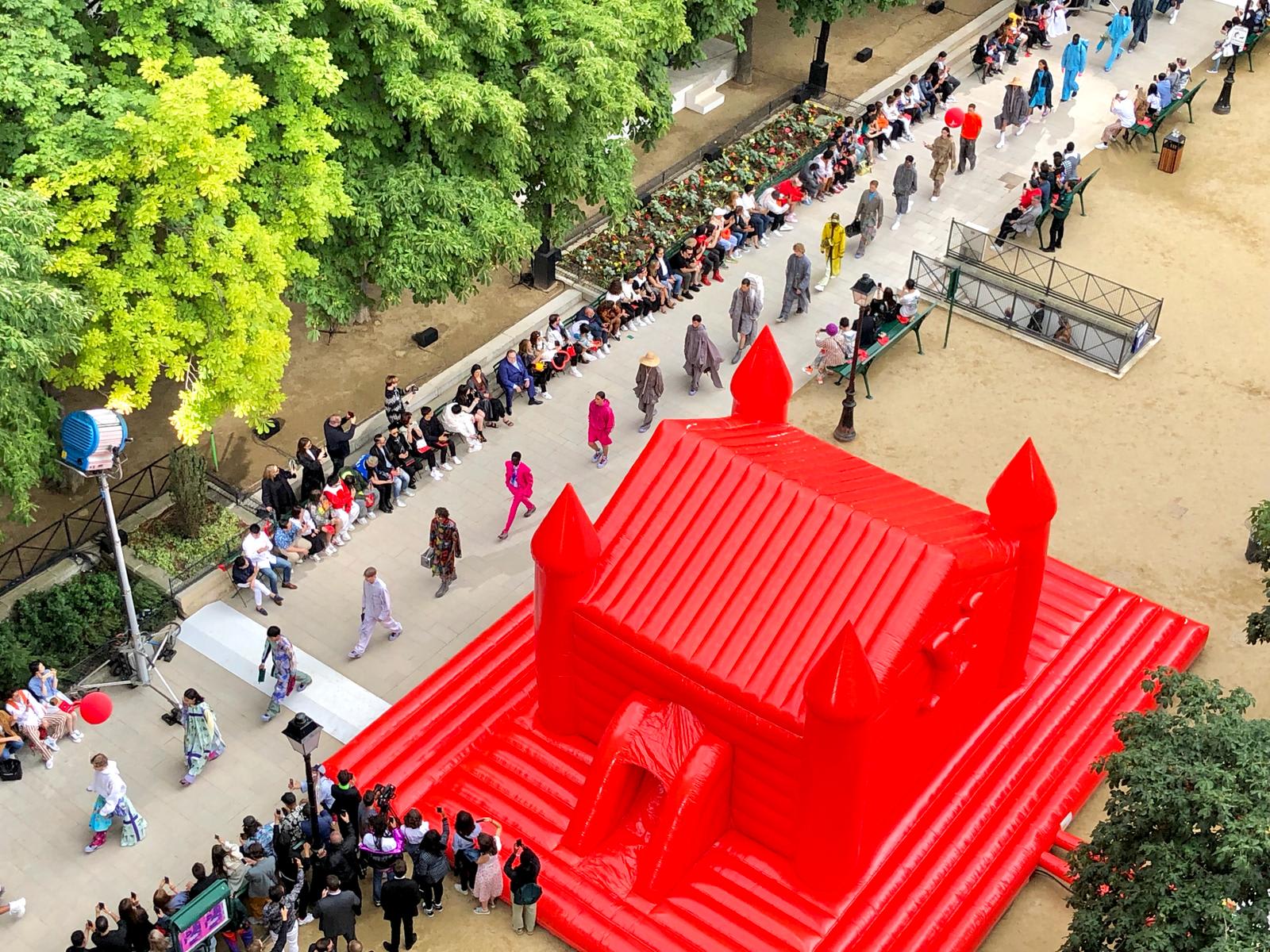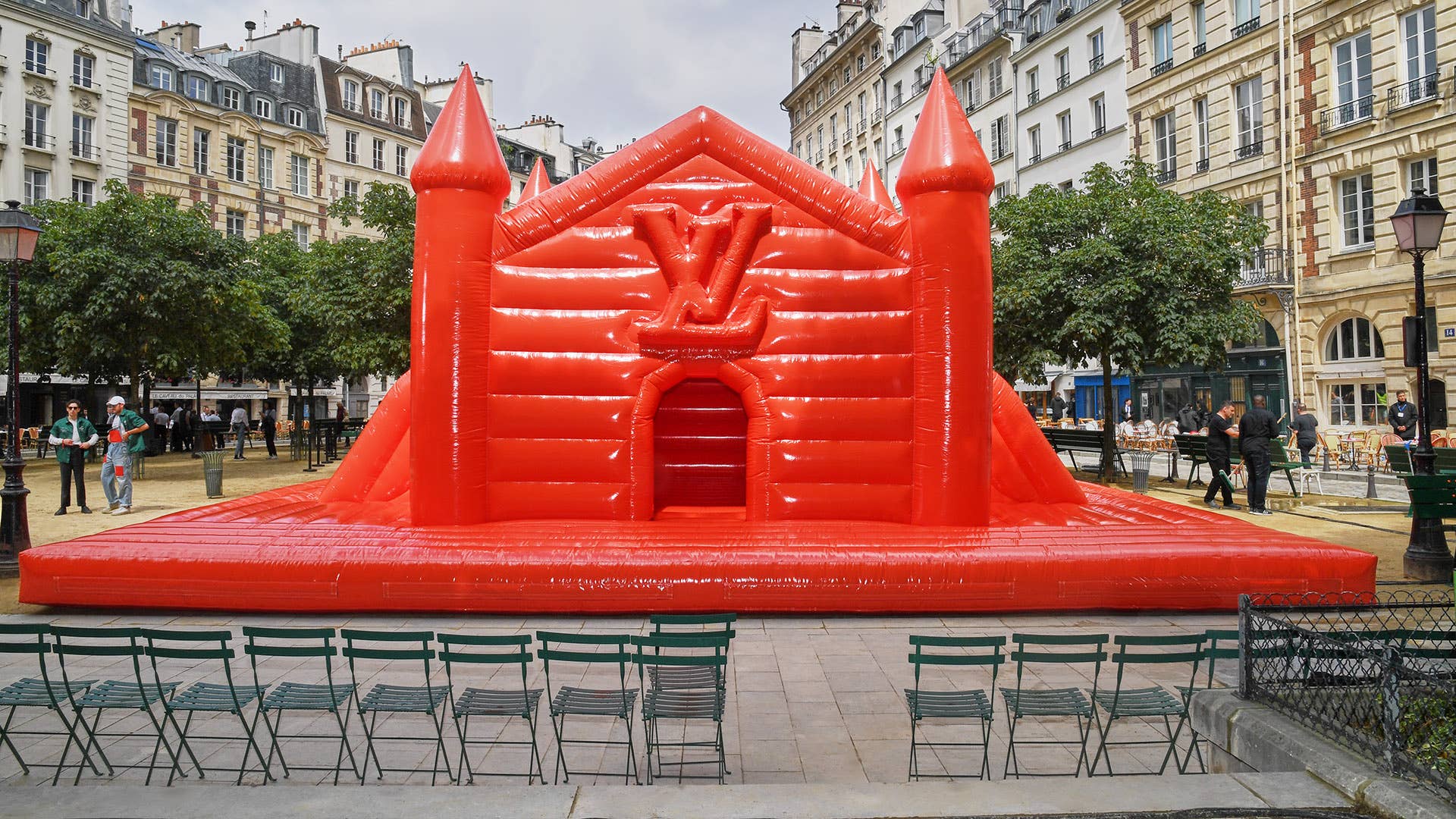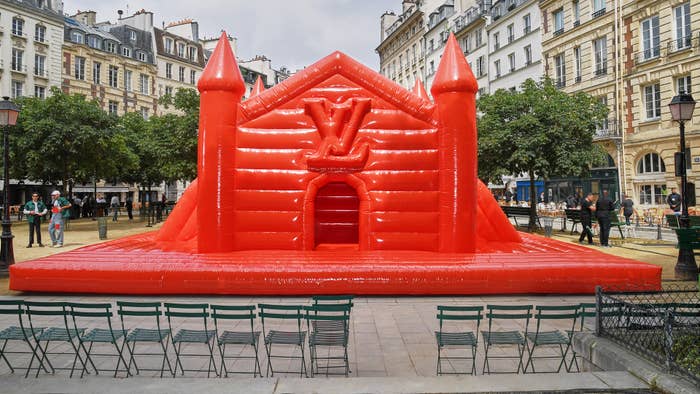
Within the last 10 years, the New York City-based creative studio Playlab, Inc. has published architecture magazines, dropped gigantic inflatable flowers in the middle of Rockefeller Center, and is currently working on building the first self-filtering swimming pool in a New York City river. But they've never helped design a fashion show. Let alone a fashion show for Virgil Abloh and the biggest luxury brand in the world, Louis Vuitton, where he serves as the artistic director of the men's line.
Playlab, Inc. is responsible for some of the most memorable elements of Louis Vuitton Men’s Spring/Summer 2020 runway show. They created the inflatable red Louis Vuitton bouncy castle that has been seen all over Instagram and those oversized monogrammed park benches that were built so that attendees' legs could dangle like children. Louis Vuitton crepe stands and branded party favors like Eiffel Tower keychains, miniature park benches, bubbles, and balloons were all apart of Playlab and Abloh's unique vision for the runway show.
“We put this idea on the table early in the process, that this show should be a block party,” says Playlab, Inc. founder Archie Lee Coates IV. “It should be outside and public as if it were a part of everyday life. Virgil just took that and turned it up 9,000 degrees to make it even stronger.”
We spoke to Coates and his Playlab, Inc. co-founder Jeff Franklin, who have worked with Abloh for the last six years, about their experiences creating with the designer, what it was like going through 10 years of his hard drives, the making of the Pyrex Vision flipbook, and how the Louis Vuitton bouncy castle went from a sketch to reality.
(This interview has been edited and condensed for clarity.)
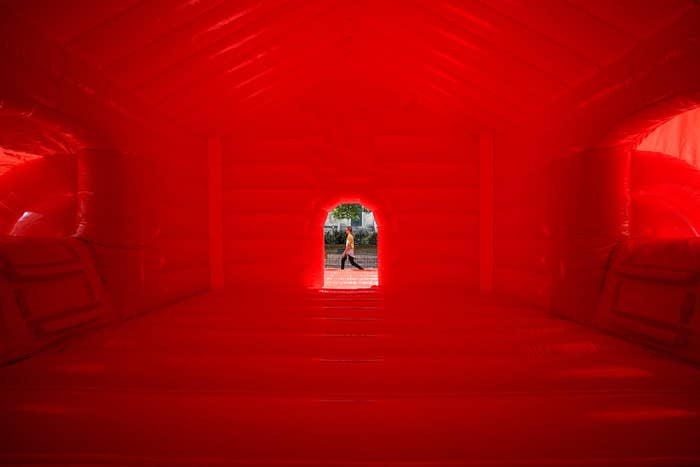
How did Playlab, Inc. become involved with Louis Vuitton’s Spring/Summer 2020 runway show.
Archie Lee Coates IV: We went to go see the Louis Vuitton and Off-White runway shows in January. Virgil came up to us and said, "Hey, I love the way that we're working together, let's do some more things. Do you want to work on the Louis Vuitton show for spring?"
So before we even had anything rolling, we just kind of started presenting ideas to him over WhatsApp and it was just so fun. Working with Virgil is freeing. For people like us that just want to make things, he's a perfect collaborator in that sense. He is going to build on top of an idea and not break it down. You're putting all these ideas out so that you can have a conversation, something percolates, and all of a sudden you see a piece that you want to make stronger and bigger. That evolved into the show and the theme of the show. There are multiple themes but it’s really about making people feel like a kid again and this beauty of boyhood, childhood, and positivity.
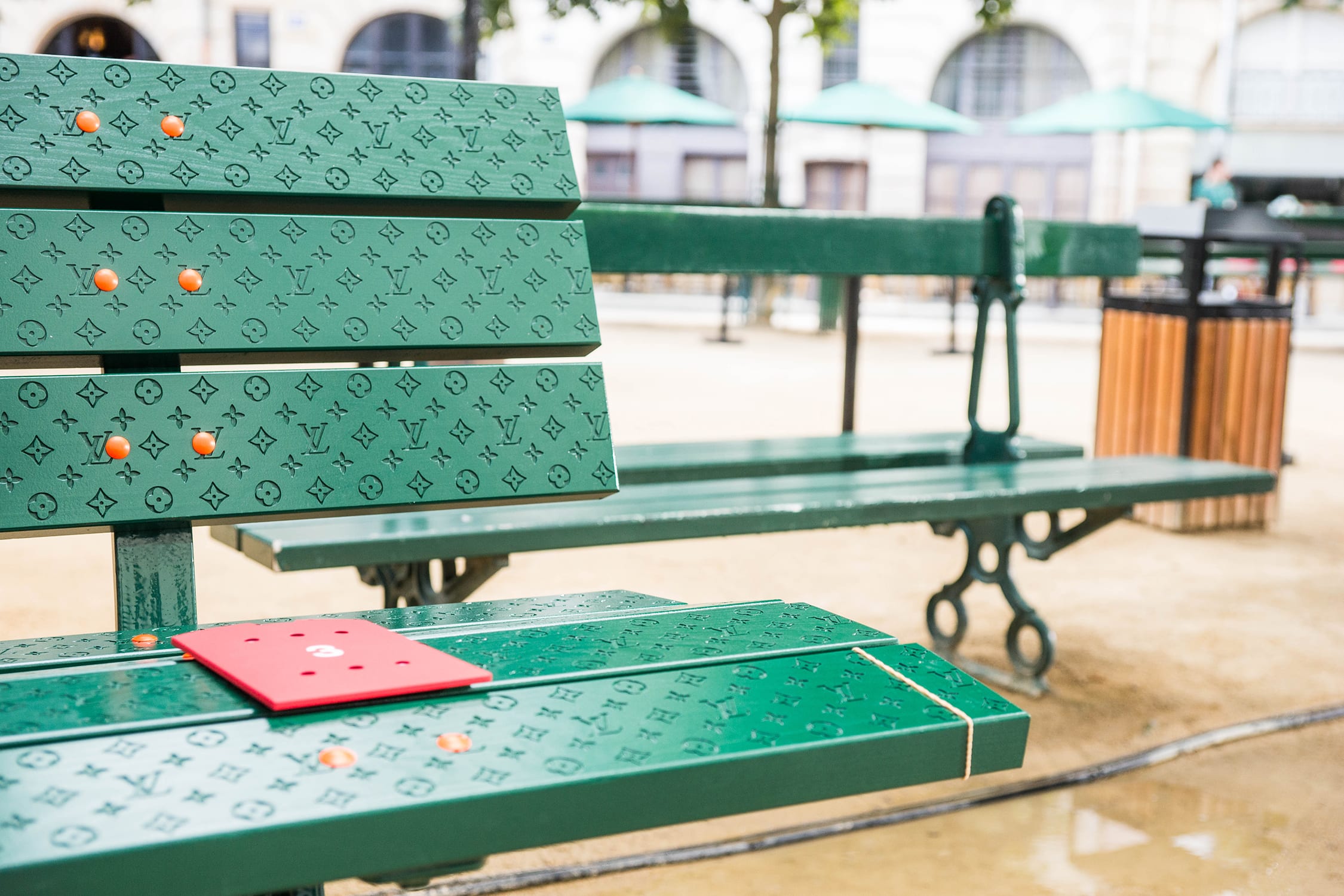
Yes, I loved that kite invitation.
Archie: Yeah, that was super smart. That was all Virgil and his team. The bouncy castle was obviously a huge component, but for us, the benches were really key. We went and surveyed all of the Parisian benches that were designed by famous civic designers over the last 200 years. We found one Virgil loved and reproduced it one and a half times its actual size. We made 15 of these benches so that when people sat on them, they looked like they were kids because their legs were dangling. It was just simple elements turned up.

Virgil has a philosophy of the three percent design twist. So we just turned everything three percent. We had models hold balloons and that was a key component even though it was super small. There was someone making balloon animals and stands for crepes. People were giving out miniature Eiffel Towers and we produced miniature Louis Vuitton benches so that guests could take a little bench home with them. That's the new icon of Paris. It's not just about the Eiffel Tower and the Arc de Triomphe. It’s about the bench that everybody sits on. There's many messages there and I'm getting chills just thinking about it.
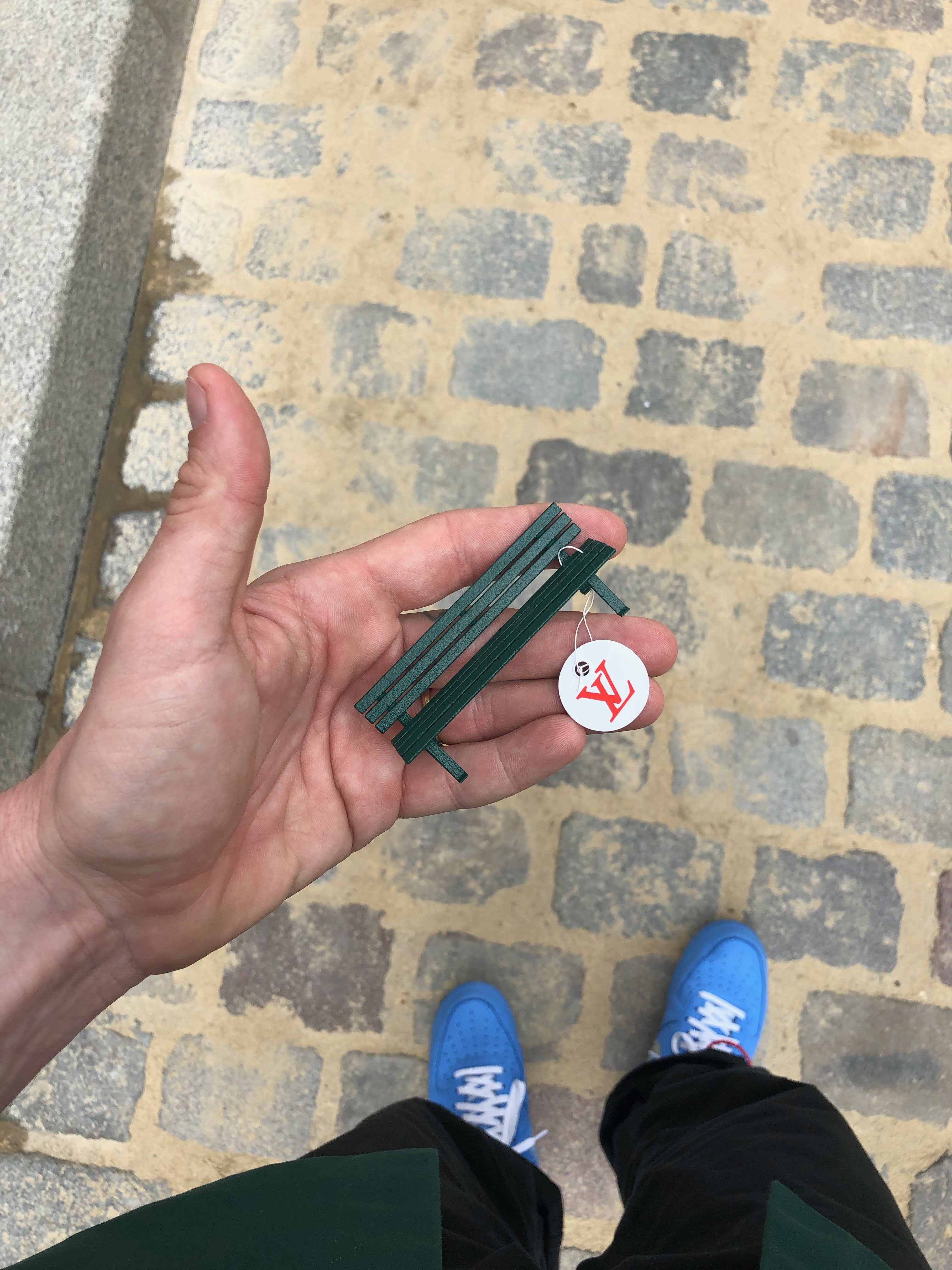
It’s interesting to see Louis Vuitton in that realm.
Jeff Franklin: He's very conscious of what the world of luxury fashion is like and what he wants to bring to it to make it fun. To bring that childlike explorative aspect to it is such a brilliant idea because it just opens up so many territories and thoughts that haven't been present in that world for so long. So the opportunities for something fun and new are just...
Archie: Endless.
Jeff: And people are open for it. Fashion has always been a place where you can simultaneously experiment with not just commerce but art. It transports people to an alternate reality that could feel real. I think it's a really interesting theater to play with.
How long did it take to design some of those elements? Like the balloon house or the benches?
Jeff: It's hard to put a specific time on it just because it was this rapid fire back and forth. For something like the bounce house, which was awesome, it was a WhatsApp conversation with Virgil. We talked about having a central element, he threw out the idea that having a bounce house would be great. The same day we sketched up 10 different versions of what that can be. He circled one, sent it to the production team at LV, and was like, "Yo this is it, let's roll with it." Another day was spent on us drawing size specifications of what it would be like. I think Virgil would be one of the first to credit the LV production staff as top notch. They're insane. They're not questioning a lot of these ideas about why we should do it. It’s more like, "Okay, how do we make this in the best way possible?" So it was awesome to see those ideas go from a sketch to a 3D render from the production team, and then getting it made. It was just about tweaking the details at a certain point. It was literally safety details like, "Oh we need to make something here so people don’t fall out."
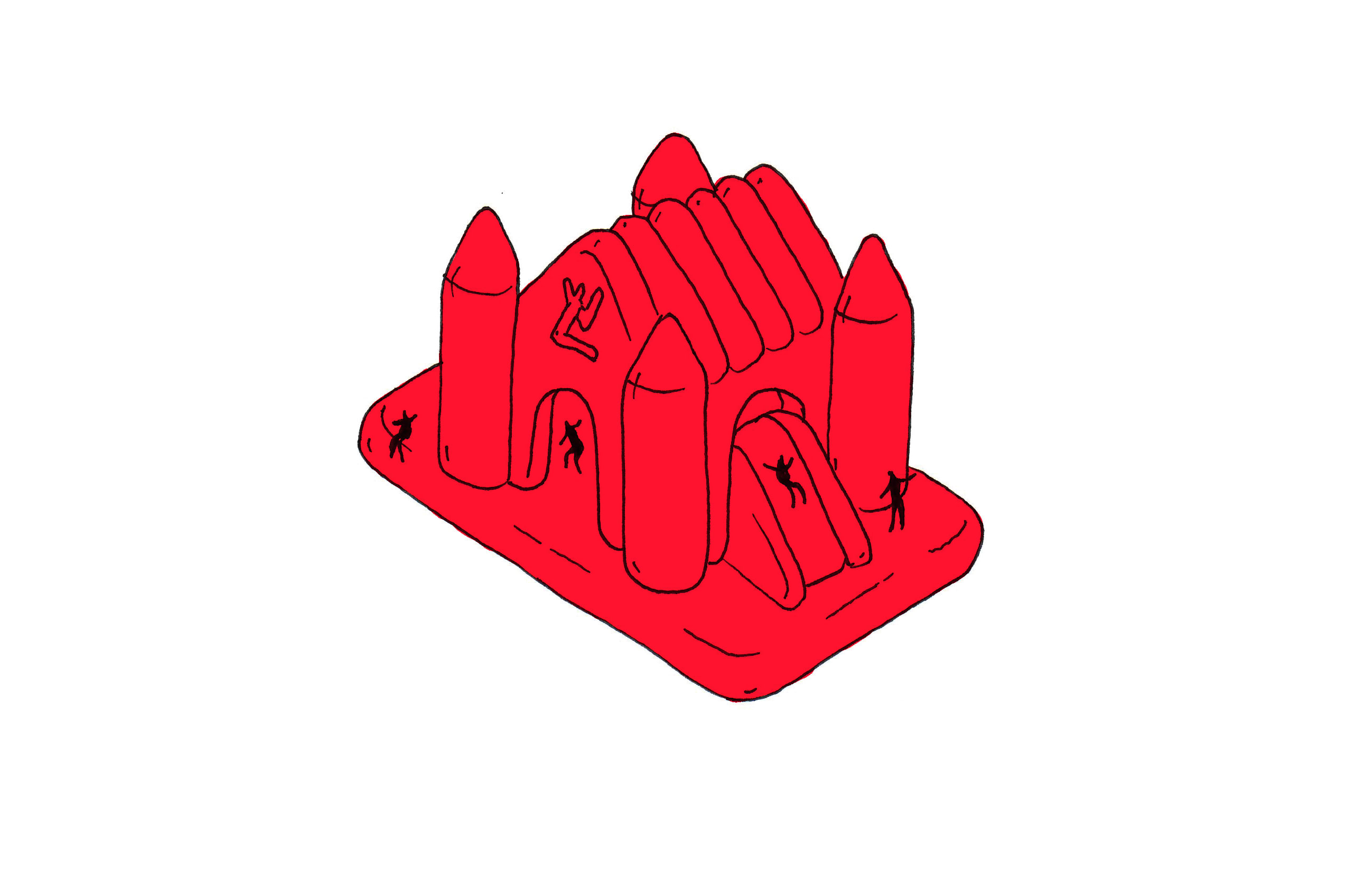
I think the only limitations we had on the bounce house was that LV needed like three weeks to physically make it. So we had to be ready a little bit further out than normal. Because for some of the ephemera—like tablecloths, ash trays, and coasters—it was made like a week before the show. But it was still awesome.
Were people going inside that bounce house?
Jeff: After the show was over, instead of going to some secluded spot, Virgil wanted to hang out there and told the DJ there to keep the party going. That was awesome.
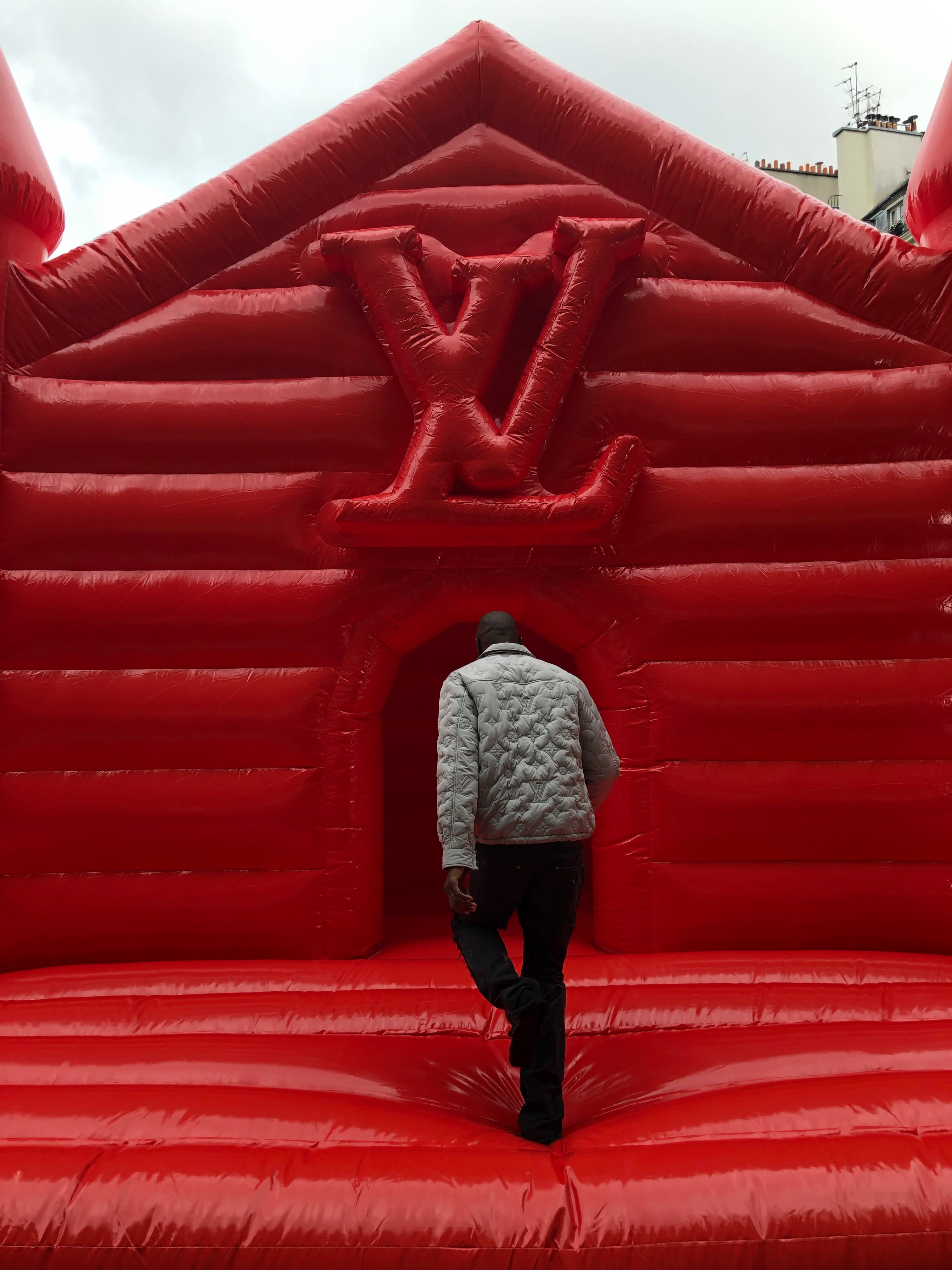
I think one of the best scenes of the bounce house was seeing Virgil get into it for the first time. Before the show started tons of the Louis Vuitton staff came and were actually hanging out in the bounce house. So it was cool to see them getting into it, too.
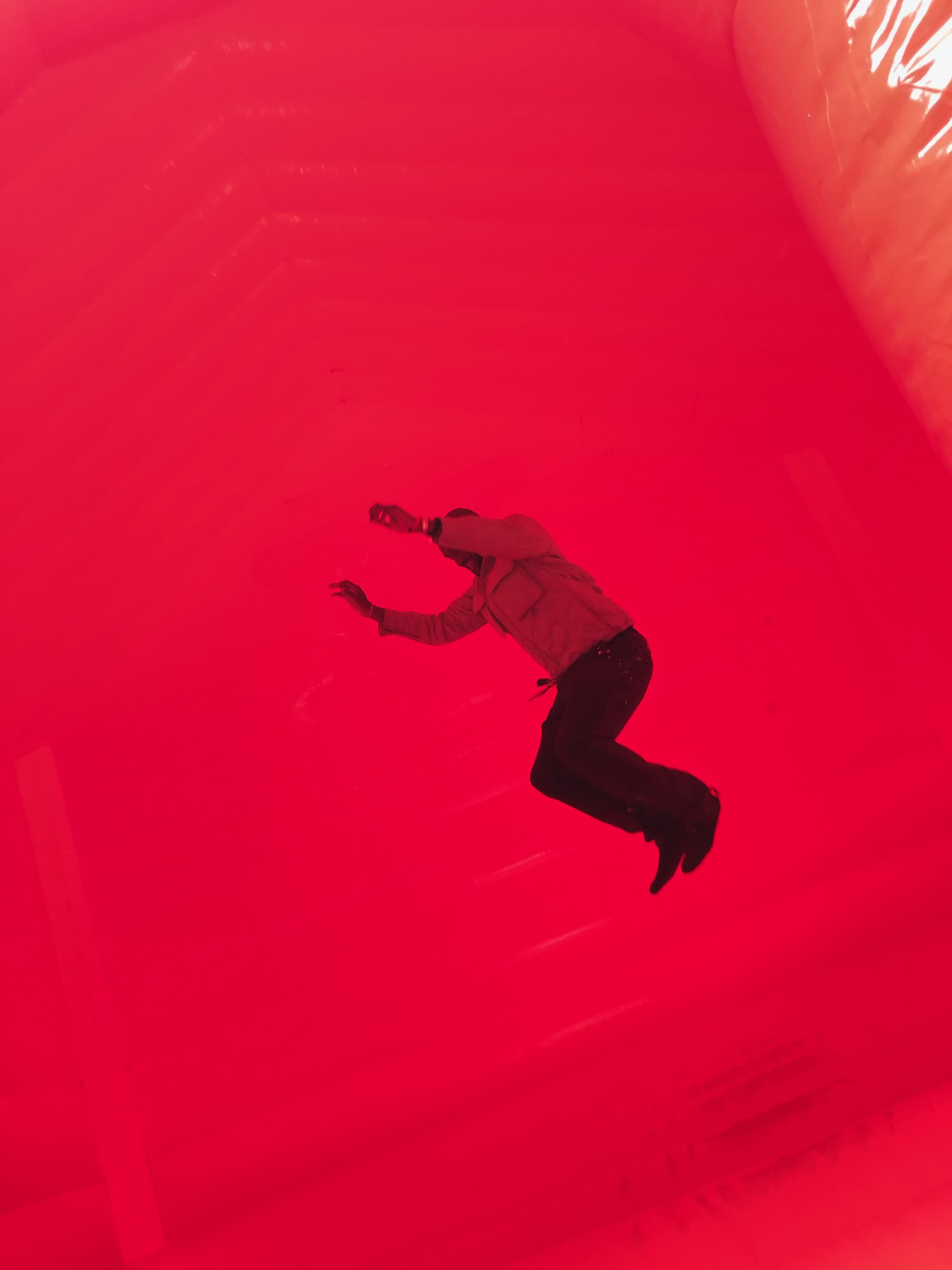
So Playlab, Inc. is 10 years old now? How would you explain what the creative studio is to someone who’s never heard of it before?
Archie: We call it a creative studio because that’s exactly what it is, right? It's a really broad practice because we want to and can do anything. But it's really about a journey of concepts and ideas. We really love ideas and realizing them in different ways. So the studio in a lot of ways is form agnostic. We're really not necessarily concerned with the discipline we're in or the form that it takes. We’re just really excited about an idea coming to life and that's what the studio is here to do. It started with Jeff and I. Now it's five of us, including Dillon Kogle, Ana Cecilia, Thompson Motta, and Phil Gibson. And no matter how big or small it is, we just want to be able to explore ideas on whatever scale we're interested in at the time.
How did your relationship with Virgil Abloh begin? I saw that one of the earliest projects you worked on for him was making this book “WET CONCRETE” for his Hong Kong store.
Archie: Our friends Dong-Ping Wong and Oana Stanescu run an architecture office called Family and they worked on Virgil's first Off-White store in Hong Kong. Dong and Oana introduced us to Virgil by giving them a copy of this magazine that we co-publish, own, and design calledClog. That magazine started as an architectural publication and Virgil, being an architect and studying architecture, kind of nerded out on it and liked it. We ended up meeting each other and he proposed making a book about the Hong Kong store. That was a cool conversation because he was like, "Let's tell the story of how the architecture happened and not about the clothes." And we're like, "Awesome."
Again, ideas, concepts, and ways of thinking. Virgil would come by the studio where we just put up all these ideas and that's how the creative process worked. The book didn't get published because of so many things. But you know, when we finally came back to do Figures of Speech, it was like we had something big to make.
Jeff: It was a cool project because the concept for “Wet Concrete” was about opening up the process on making this space in Hong Kong. We show how through WhatsApp messages, text messages, and emails. We were being very open, showing all the messages as much as possible, so that people can understand the back and forth working process.

Which, fast forward six years later, plays a huge part in Figures of Speech. There's 400 pages of this book that are exactly that. Showing what's the process behind making all these things and what that looks like. All this stuff that didn’t get made, including that book we designed for Virgil six years ago, is featured in Figures of Speech because it was a part of the process of all the work that's been done.
Virgil is very generous with how open he is and showing people the process. That was a major part of both books. It was about being able to show people that his work is not some secretive thing that's behind closed doors. He wants to make it open and show people what he's doing so that you can feel like yourself doing it as well. That’s an empowering and awesome thing to be a part of.
Playlab, Inc. was heavily involved with the third section of the Figures of Speech book. Which is titled the “Archive.” What was it like developing that part of the book?
Jeff: It was crazy. We met with Virgil at the Mercer hotel and he gave us one hard drive, that had all of his hard drives, computers, and phones all merged into one from the past 10 years.
It was a very open brief. "Hey, I think it would be great to go through this and find the highlights of these projects, and what’s the process behind them, for the past 10 years. Essentially it's up to you guys to go through this and find what you think tells that story. Whatever you think is cool and we'll collect it."

Archie: We had no idea it was going to be so massive. But once we started to dive in and comb through the digital archive, and then a physical box of just papers that showed up. We just realized there was so much rich material. It was hard to actually get it down to 400 pages. We had a lot more that isn't shown. But the process was really super open and he basically was kind of like: "You've got free reign and kind of go through and see what you think tells the right story."
What was your favorite discovery from those harddrives?
Archie: Iterations. There were a lot more iterations than we expected. During the Kanye days, he was literally glued to his laptop just creating. That's why the first page of the Archive section is titled 10,000 hours. You spend so many hours wrapped up in trying things that you see why there's so much stuff that gets made, which is beautiful. That’s the way we were trained in architecture school, too. It’s to iterate, iterate, iterate.
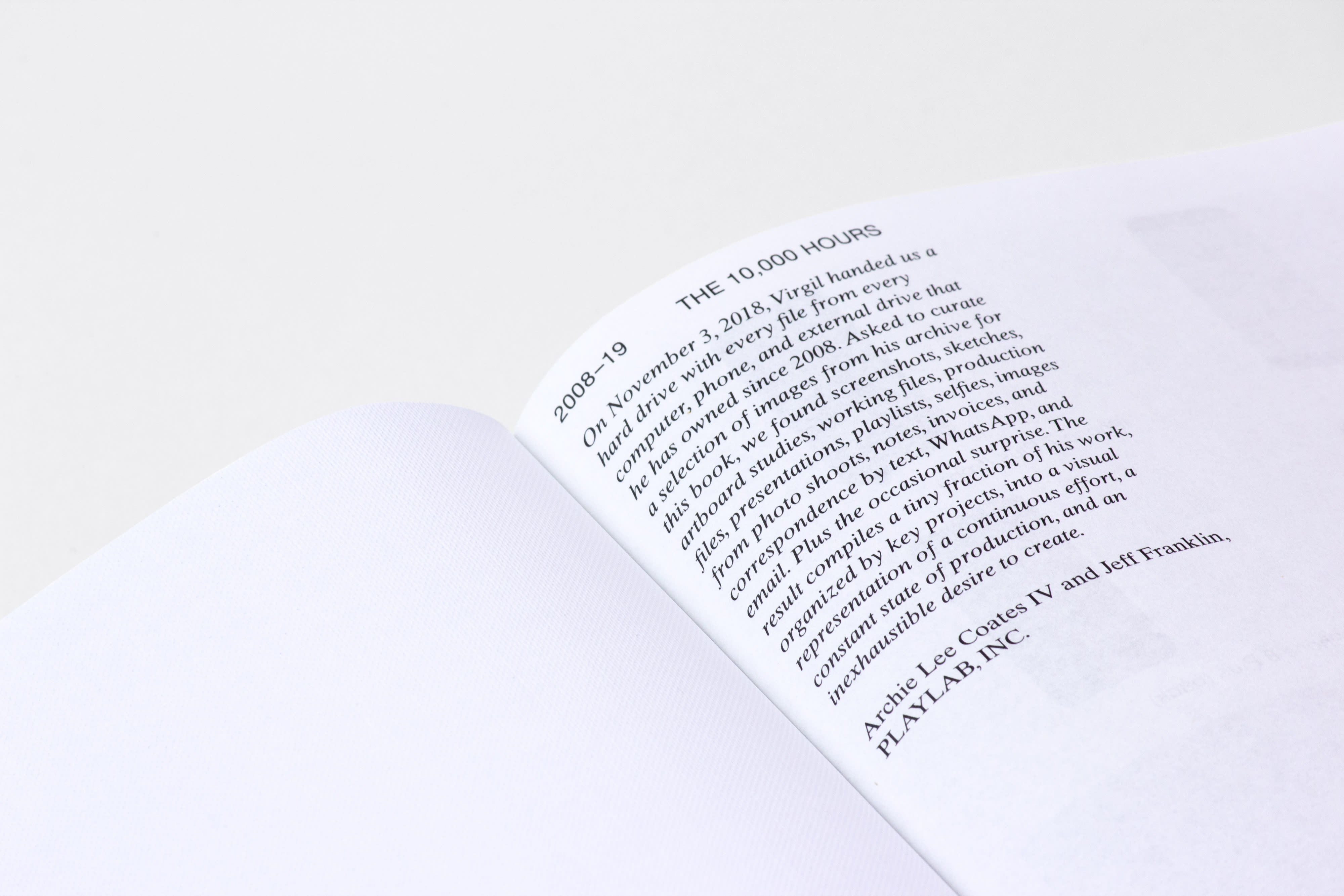
Jeff: It was also seeing how he works on fashion. Seeing those mockups in Photoshop and seeing how that translates into the physical clothing world. It was just awesome to see what that process is like and we were imagining that for so many people it would be an empowering way to understand how that process can work. Without having the tools and the resources at your disposal, you can do a lot in the computer to help push an idea further. It was awesome to see how he went through that from the iterative standpoint.
How did the Pyrex Vision Flipbook come about?
Jeff: Yeah, that was awesome. We were actually at his Louis Vuitton office after a marathon meeting about the MCA book and I think we were just on our way out. We were talking about other projects that we wanted to potentially work on together and he was like, "Yo, I'd love to make a flip book that's based around the Pyrex video because it just feels like a great format to share that." And we were like, "All right, sick, let's do it."
So we literally came back to our studio and just asked Virgil and his team if we could get the video to start mocking it up. Nobody gave us a project brief or a budget. We just got the ball rolling and put together the files to show what it could look like.
Archie: And the concept of it, for anybody this is like a collectible toy. You don't even want to open it because it's so important to the genesis of, not just Virgil’s trajectory, but a blueprint for everyone else's trajectory. So we put it inside collectible toy packaging and made it cheap. You can buy it for like nine bucks.
Jeff: One of the most fun parts of making that book was figuring out the packaging. A flip book only becomes useful when you can actually flip it. But if it's in a toy packaging, you've got to break it open to use it. We wanted to kind of play with the collectible nature of it. We all bought two so we could open one and keep another in its package.
I'm kind of just curious to know more about this Playlab, Inc. employee, Dillon Kogle, and his sneakers
Archie: We've been working with a lot of footwear brands for a long time. Jeff and I had always been interested in Nike’s and when Dillon came on board it was like his secret interest. He wanted to make shoes so he just started cutting up old shoes and taking materials and kind of collaging them.
A big part of PlayLab is initiating projects. From Plus Pool, to Clog, to even opening a pie shop in Alabama. Even the way we work with Virgil, we propose things, you know? So the shoes is just another method. It's another way of us to figure out how to work together and figure out how to get better at concept development.
We're debuting an entire size run of one shoe design at our first museum show in Colorado at Black Cube Art Museum. PlayLab should be a place where people are flowering, right? To have the freedom to explore ideas just like the studio does for everyone else. So yeah, the shoes is something that we don't have a plan for. We're just trying to see where it goes.
I think for Jeff and I, when we see something that we love, we ask, "Why can't we make it?" And so shoes were just one of those things like, "Man, everybody's making a shoe. I want to learn how to make a shoe. That seems fun."
Jeff: I was just thinking about the question of "Why can't we make it?" and maybe one of the effects of Virgil is feeling more confident in saying, "Oh we can make it." Instead of saying "Why can't we make it?" we're like, "Oh we can make it." You don't do anything alone. Virgil doesn't do anything alone. We don't do anything alone. It's about finding the right people to collaborate with to help you make those things happen.
How has working with Virgil informed your own perspective on design?
Archie: It just reinforced it because the way of thinking is so similar. Architects are trained in a very specific way. And then from there you kind of flower and create your own paths or processes.
For us, working with Virgil just sort of validates the way that we think and makes you feel a little less alone in that. And it's really like a family thing. It just feels strong and healthy and that's what's cool. And then to Jeff's point, working with Virgil in any capacity and the people that are around him, everybody's happy to be there. Everybody's really happy to do what they're doing. There's a lot of positive energy and you also meet so many other people in his world that are also doing incredible things. So our friendships have gone through the roof and we've met more like minded people in the past year than we have in 10 years. I think Virgil is really good at gravitating towards positive people that want to make great things.
